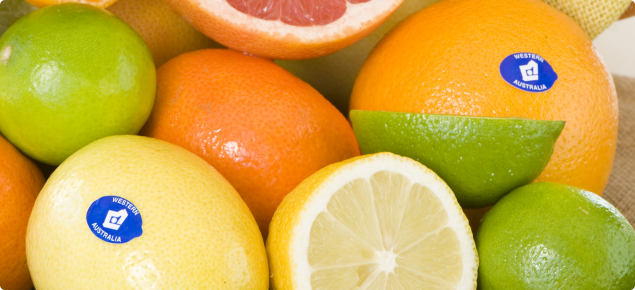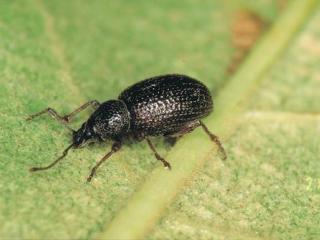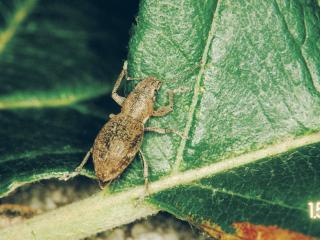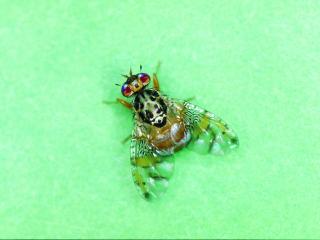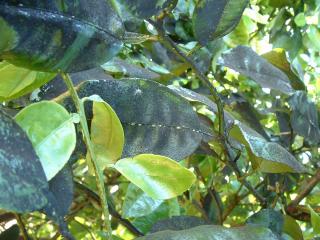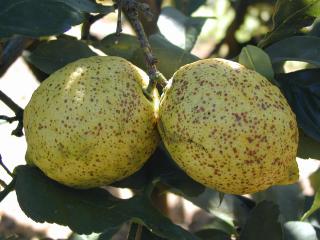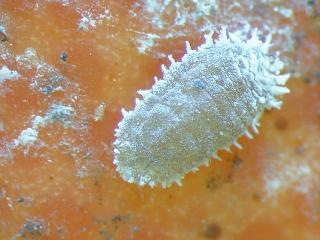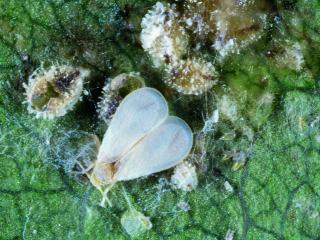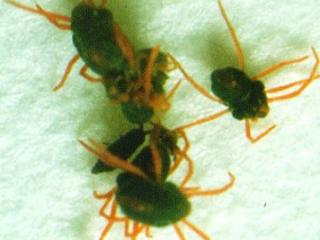Chewing insects
Citrus leafminer
Citrus leafminer (Phyllocnistis citrella) is the larva of a small moth originating from south-east Asia and is commonly seen in backyard citrus trees. The larva infests young foliage in early autumn, peaking in April or May and feeds within the leaves creating distinctive silvery tunnels or 'mines'.
They can cause severe damage to the leaves of trees less than three years old. Established trees are less affected. Damage is usually worst when there is new flushing growth in early autumn, depending on temperature.
Citrus leafminers are naturally controlled by small parasitic wasps. Damaged leaves can be pruned out but if chemical control is required spray new foliage with horticultural oil from summer to autumn.
Lightbrown apple moth
Lightbrown apple moth (Epiphyas postvittana) caterpillars are a native species occurring from spring to autumn and are up to 20mm long. They can be found in protected areas where fruit, or fruit and leaves touch, or in the navel of some navel orange varieties. The caterpillars produce a protective web under which they feed.
Lightbrown apple moths are naturally controlled by wasps like Trichogramma which parasitise the eggs, while caterpillars are parasited by braconid wasps. Oechalia schellembergii bugs will also predate on the adult moth.
For chemical control, a mixture of garlic, chilli and pyrethrins is commercially available as a low toxicity pesticide.
Native budworm
Native budworm (Heliothis punctigera) is an occasional spring pest on fruit trees in Western Australia. The caterpillars feed on shoots, flowers and newly set fruit, causing fruit drop. The caterpillars may grow to 40mm long and can be green or brown in colour. Often the level of damage is not sufficient to warrant chemical control but if required, the biological insecticide Bacillus thuringiensis is effective on young caterpillars.
Lemon bud moth
The larva of the lemon bud moth (Prays parilis) feeds on the flowers of lemon trees and can cause fruit to become misshapen and deformed. The larvae are yellowish to reddish-brown in colour and grow up to 10mm long. They are most commonly found within the buds of unopened lemon flowers.
Affected flowers can often be identified by the small exit hole left by larvae. Chemical control is only required for big infestations. Try garlic extract as a repellent and check with your local garden centre if chemical controls are needed.
Weevils
Weevil species causing damage to citrus trees in Western Australia include the apple weevil (Otiorhynchus cribricollis), garden weevil (Phlyctinus callosus) and fullers rose weevil (Asynonychus cervinus).
Weevils damage leaves and occasionally the fruit. Garden weevil and apple weevil can be trapped and then destroyed by attaching corrugated cardboard strips about 15cm wide around the trunks of trees.
The weevils, which feed at night, will shelter under the cardboard during the day which can then be removed and destroyed. Fullers rose weevil shelters in trees and cannot be controlled using this method. Use fluffy Dacron (quilt wadding) bands around tree trunks to slow the movement of weevils into the tree canopy.
Mediterranean fruit fly
Mediterranean fruit fly or Medfly (Ceratitis capitata) is the most common pest on citrus in home gardens in the metropolitan area and country towns and is particularly active between November and July. First detected in Western Australia in the 1890s, Medfly will attack most citrus, especially mandarins and oranges.
The presence of small piercing holes in the fruit indicates that eggs were laid under the fruit skin and that maggots, up to 8mm long, may be present. The maggots tunnel into the fruits and cause rotting, often resulting in premature ripening and fruit drop.
Adults can be controlled with weekly baiting of leaves with a splash bait containing spinosad which is derived from a bacterium and is a contact and stomach poison. Commercial or homemade baits should be hung in the tree to indicate the presence of the fruit fly and reduce their numbers.
To protect the crop the individual fruits can be bagged or the tree covered with exclusion fabric netting. Only leave the covers in place while the fruit is ripening.
To get rid of infested fruit, seal them in plastic bags and place bags in a bin, freeze or microwave the fruits or place fruit in water with a small amount of cooking oil on the water surface. The oil layer will suffocate the larvae. Medfly larvae can survive burial, so this method is not recommended for fruit disposal.
For further information on control and recipes for baits consult our article on Mediterranean fruit fly.
Sap-sucking insects
Honeydew producing insects
Scale, mealybug, aphids and whiteflies are closely related species that suck plant juices with specialised mouthparts. Honeydew, a sweet, sticky liquid, is excreted as a by-product of their feeding. The honeydew drips onto leaves, twigs, fruit and furniture, on which the sooty mould establishes.
Although sooty moulds do not infect plants, they can cause indirect damage by interfering with photosynthesis. This can stunt plant growth and coated leaves may also drop prematurely. Fruit covered with sooty mould are edible and the mould can be removed from the fruit with a solution of mild soap and warm water. A horticultural oil will control the insects.
Scales
Scales are unusual insects appearing to lack legs and eyes. Most species are usually only mobile when young and remain stationary on the plant as adult insects. Red scale (Aonidiella aurantii) is a major pest in Western Australian home gardens, infesting leaves, fruit, twigs and limbs. They are attacked by small parasitic wasps including Aphytis melinus and by ladybirds. Control bad infestations with horticultural oil which suffocates the insects.
Other scale pests sometimes seen on citrus trees in Western Australia include soft brown scale (Coccus hesperidum), black scale (Saissetia oleae), citricola scale (Coccus pseudomagnoliarum), white wax scale (Ceroplastes destructor), cottony cushion scale (Icerya purchase) and hard or Chinese wax scale (Ceroplastes sinensis).
A number of different preditors and parasite species have been released in commercial orchards over the years to help control different scale insects indcluding parasitic wasps. Some ladybird species are also predators of scale insects.
Aphids
Aphids are small, 1-3mm, pear-shaped, soft-bodied insects. They can be winged or wingless and are usually slow moving. The black citrus aphid (Toxoptera citricida) is an exotic species commonly found on Western Australian citrus.
Aphids are most abundant when there is new, flushing growth, usually in September/October and February to April. The aphids cluster on blossoms and young shoot growth, causing twisting and distortion. Aphids also excrete honeydew on which sooty mould can grow.
Aphids are attacked by a wide range of naturally occurring beneficial insects including small parasitic wasps, ladybirds, lacewings and hoverfly larvae. For chemical control, a spray containing garlic, chilli and pyrethrins is commercially available as a low toxicity pesticide.
Mealybugs
Mealybugs are coated with a fluffy layer of wax. Two exotic species, citrus mealybug (Planococcus citri) and the long-tailed mealybug (Pseudococcus longispinus), attack Western Australian citrus trees. Mealybugs are up to 3mm long and are found on naval ends and under calyxes of fruit, as well as between touching fruit and leaves. Long-tailed meaybugs have long white ‘hairs’ extending from the tail region, whereas citrus mealybugs do not.
Apart from parasitic wasps, the ‘mealybug destroyer’, a native ladybird species (Cryptolaemus montrouzieri) and lacewing are natural control agents.
Use horticultural oil to control scale or horticultural soap or oil to control aphids and mealy bugs.
Whiteflies
Whiteflies resemble tiny, snowy white moths. The native whitefly, (Orchamoplatus citri), attacks backyard citrus in Western Australia. The adults, eggs, larvae and pupae are often found on the underside of leaves. Native citrus Whitefly is attacked by a range of naturally occurring predators including ladybirds, lacewing, hoverfly larvae and some beetles.
Mites are less than 1mm in size and often tick or spider-like in appearance and adult have eight legs. Species such as two-spotted mite are just visible to the naked eye, while others including the brown citrus rust mite and citrus bud mite can only be seen with the aid of a microscope. In Western Australia, two-spotted mites and citrus bud mites are the most common citrus pests.
Ants
Honeydew producing insects are often actively transported, ‘farmed’ and defended by ants. Ants use the honeydew as a food source while the insects are protected from parasites and predators. Controlling the ant population will therefore also reduce these pests. To control ants, send a small sample on a small piece of sticky tape to the Pest and Disease Information Service (PaDIS), for identification and advice on control methods.
Non-honeydew producing pests
Crusader bugs
Crusader bugs (Mictis profana) are up to 25mm long, with a pale yellow to orange cross on their backs and can spray a stinking fluid when disturbed. They are a native species and can occur year-round. On citrus trees, they feed by sucking on young shoots causing the shoot tip to wilt and die.
They are controlled naturally by assassin bugs (Pristhesancus plagipennis), lacewings, by small wasps which parasitise the eggs and by Cryptolaemus montrouzieri which is a native ladybird known as the ‘mealybug destroyer’.
Mites
Mites are less than 1mm in size and often tick or spider-like in appearance. Adults have eight legs. Species like the two-spotted mite are just visible to the naked eye, while other mites such as the brown citrus rust mite and citrus bud mite can only be seen with the aid of a microscope. In Western Australia, two spotted mites and citrus bud mites are the most common. Control bad infestations with sulphur, horticultural soap or a horticultural oil spray.
Two-spotted mite
These mites (Tetranychus urticae) feed mainly on lower surface of leaves causing a typical yellow stippling or spotting effect. Occasionally, damage can also occur to fruit. Two-spotted mites are particularly active in warm to hot conditions and numbers can be reduced by spraying water beneath the foliage. Mite-eating ladybirds and predatory mites are natural control agents. Chemical control is usually not required.
Citrus bud mite
Citrus bud mites (Aceria sheldoni) can attack all citrus varieties but damage is mainly seen on lemons. Active year round symptoms of bud mite damage are distorted flowers, fruit and shoots. The mites usually hide inside leaf and flower buds, making control difficult.
Thrips
Thrips are small, slender soft-bodied insects just visible to the naked eye. Adults are only about 2mm long. Two exotic species of thrips damage citrus in Western Australia: Kelly’s citrus thrips (Pezothrips kellyanus) and greenhouse thrips (Heliothrips haemorrhoidalis). Kelly’s thrips feed under the calyx of young fruit causing scarring which develops into a distinctive halo as the fruit matures. Greenhouse thrips feed on the leaves, between touching fruit, or where leaves or stems touch the fruit. This results in the production of grey scars or “bleaching”.
Natural predators and parasites of thrips do occur or you can control the pests with sprays of horticultural soap or pyrethrin.
Citrus gall wasp
Citrus gall wasp is a pest of citrus trees grown in backyards and orchards. Citrus tree owners are encouraged to implement control measures on their property to reduce the threat to the citrus industry in Western Australia.
Swollen lumps on the young stems of citrus trees signal egg-laying activity by the wasps. The swellings get bigger as the wasp larvae grow. Please report suspected sightings to the Pest and Disease Information Sertvice (PaDIS). See Citrus gall wasp control for more information.
Other garden pests
Birds
Birds are generally less of a problem for citrus than for many other fruit types. However cockatoos, parrots and other birds may occasionally damage new shoots, twigs flowers and the fruit of citrus trees. Cover trees with netting or use a bird repellent containing aluminium ammonium sulphate to repel birds.
Rats and possums
Rats and possums are common pests of citrus and will eat the peels of fruits. Sometimes they will leave the peel and eat the flesh or the entire fruit. Control rats with baits. The best deterrent for possums is an old stocking stuffed with dog hair.
Snails and slugs
Common garden snails and slugs feed on leaves and fruit at night, making holes and marks on fruit. Snails are also known to be responsible for ringbarking young shoots, twigs and trees resulting in twig and tree death in severe cases.
Snail and slug numbers are reduced naturally by some birds, lizards and sciomyzid flies. To reduce the snail and slug populations in your garden use snail traps or commercial baits. See Managing snails in citrus orchards for more information.
Caution
Chemicals can destroy beneficial insect populations that may be providing natural control of pest insects in your garden. Horticultural oils, horticultural soap and sulphur can burn foliage if used incorrectly and should not be used in hot weather. Follow label instructions.

